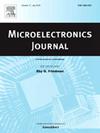无电桥无源自激振荡交流低压能量采集电路
IF 1.9
3区 工程技术
Q3 ENGINEERING, ELECTRICAL & ELECTRONIC
引用次数: 0
摘要
目前,大多数电磁能量收集器使用电容器电压倍增器或由外部信号控制的升压电路来升压和储存能量。然而,对于大多数低压输出电磁能量收集器来说,产生开关控制信号和整流会导致大量能量损耗。为了减少这些损耗,本文提出了一种无需额外电源或整流桥的交流升压电路,设计用于低压电磁能量收集。理论分析和实验结果都证实了所提接口的有效性。结果表明,该电路可以在 0.48V 的初始电压下启动自激升压,并在 0-2.9V 的输入电压范围内实现 71.3% 的交流-直流转换效率。本文章由计算机程序翻译,如有差异,请以英文原文为准。
A passive self-excited oscillation AC low-voltage energy harvesting circuit without a bridge
Most current electromagnetic energy harvesters use capacitor voltage multipliers or boost circuits controlled by external signals to step up and store energy. However, for most low-voltage output electromagnetic energy harvesters, generating switching control signals and rectification results in significant energy loss. To reduce these losses, this paper proposes an AC boost circuit without additional power supply or rectifier bridge, designed for low-voltage electromagnetic energy harvesting. Both theoretical analysis and experimental results confirm the effectiveness of the proposed interface. The results show that the circuit can start self-excited boosting at an initial voltage of 0.48V and achieve an AC-DC conversion efficiency of 71.3 % within an input voltage range of 0–2.9V.
求助全文
通过发布文献求助,成功后即可免费获取论文全文。
去求助
来源期刊

Microelectronics Journal
工程技术-工程:电子与电气
CiteScore
4.00
自引率
27.30%
发文量
222
审稿时长
43 days
期刊介绍:
Published since 1969, the Microelectronics Journal is an international forum for the dissemination of research and applications of microelectronic systems, circuits, and emerging technologies. Papers published in the Microelectronics Journal have undergone peer review to ensure originality, relevance, and timeliness. The journal thus provides a worldwide, regular, and comprehensive update on microelectronic circuits and systems.
The Microelectronics Journal invites papers describing significant research and applications in all of the areas listed below. Comprehensive review/survey papers covering recent developments will also be considered. The Microelectronics Journal covers circuits and systems. This topic includes but is not limited to: Analog, digital, mixed, and RF circuits and related design methodologies; Logic, architectural, and system level synthesis; Testing, design for testability, built-in self-test; Area, power, and thermal analysis and design; Mixed-domain simulation and design; Embedded systems; Non-von Neumann computing and related technologies and circuits; Design and test of high complexity systems integration; SoC, NoC, SIP, and NIP design and test; 3-D integration design and analysis; Emerging device technologies and circuits, such as FinFETs, SETs, spintronics, SFQ, MTJ, etc.
Application aspects such as signal and image processing including circuits for cryptography, sensors, and actuators including sensor networks, reliability and quality issues, and economic models are also welcome.
 求助内容:
求助内容: 应助结果提醒方式:
应助结果提醒方式:


